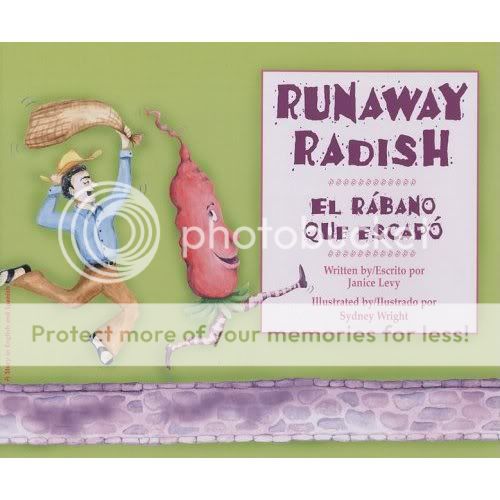
The summer is right upon us. I love this time of the year. Both my children where born en el verano, so we’ll be celebrating two birthdays in the coming months. But summer also means vacation, so it’s easy to forget about the importance of reading during this time. In an effort to give you plenty of recommendations for bilingual books you can read with your children, ReadMe, our literacy and author interview series, will be coming to you twice a month this summer.
We begin this bimonthly change with a book my daughter, Vanessa, finds hilarious: The Runaway Radish by Janice Levy. Written in a style similar to The Gingerbread Man—which tries to avoid being eaten—this is the story of all the crazy things the protagonist, a runaway radish, must do in order to escape being carved into a sculpture! Throughout the whole book, the radish sings a song as it tries to get away from the burro, the mariachis and the cooks who are trying to stop it. Thanks to the repetitiveness of this particular line, you can almost hear the radish sing it.
“Gentes y lugares voy a visitar. Aléjate de mí, ¡no me vas a tallar!“
One of the things I love the most about this bilingual book, published by Raven Tree Press, is that it’s based on a traditional Mexican festival in the state of Oaxaca held right before Christmas. So besides adding one more book to your children’s bilingual library to help you reinforce their Spanish, The Runaway Radish, also presents you with an opportunity to start talking about culture and traditions which is such an important part of raising bicultural children.
“My work is often inspired by my traveling. Wherever I go, I take a notebook and recorder. I let my five senses loose and they report back to me, with scraps of dialog, flavors and smells,” explained Levy, who’s worked very hard to become bilingual. “I’ve been to Mexico numerous times. On a trip to Oaxaca, I saw a poster mentioning The Night of the Radishes, an annual festival held on the evening of December 23rd. A huge contest featuring figures sculpted from radishes is one of the highlights of this festival. The sculptures often represent scenes of the birth of Jesus or other scenes expressing the history and culture of Oaxacans. Everyone competes for first prize, a part of which is having his picture posted in the morning paper. These are not the little round radishes we enjoy in a salad. These are specially grown radishes, long and thick skinned, that grow up to two feet in length and weigh as much as five to ten pounds.”
The author, who grew up in a monolingual family but became bilingual “through hard work and determination,” said her book was translated to Spanish because, as with her other books, she wanted to reach as many children as possible.
“I envisioned “The Runaway Radish” in bilingual, E.S.L. and foreign language settings; in homes, libraries and schools. Although the text is simple enough for a young child to read, this book is also used in middle and high school Spanish classes,” Levy added.
She strongly believes in the power of bilingualism and clearly remembers falling in love with Spanish when she was in school, even though no one in her family spoke it.
“I remember the day I stopped thinking in English. All of a sudden, Spanish flew out of my mouth like magic. It was like breaking a secret code. From then on, it just became fun; eavesdropping on conversations in an elevator, translating for a stranger in a store, hearing a joke and laughing at the right moment,” she explained. “To this day, Spanish is a big part of my life. I watch tv - telenovelas, variety shows and the news, with a dictionary nearby. I frequent libraries; I’ll read bits and pieces of everything.”
Levy has traveled quite a bit throughout Latin America, she has a Master’s in Spanish and taught ESL and Spanish before she became a writer.
“I never wanted to be a writer. My dream was to play centerfield for the New York Yankees. I’m still waiting for the call, but in the meantime, I have something to keep me busy,” she said.
For someone who didn’t want to be a writer, Levy has written quite a few books for both adults and children, including several which deal with multiculturalism. In fact, she’s written two books about one of our favorite celebrations: Day of the Dead. There’s one called, Abuelito Eats With His Fingers, which is about how un abuelito and his granddaughter figure out a way to overcome the language divide, he only speaks Spanish and she only speaks English, to create a loving bond. I bet lots of families can identify with that story.
I really enjoyed the interview with Levy. She brought up a lot of great points in terms of reading and how to always make sure it’s not a chore. Check out the rest of the interview:
Writing is like that circus act with the spinning plates; I toss up the words and twirl – going as fast as I can. I don’t outline or sketch characters; there’s no greasing the parts – I just hit the pedal. When asking for directions in Costa Rica, I was often told, “the road will take you there.” I don’t edit or agonize along the way; I travel light. As Yogi Berra said, “When there’s a fork in the road, take it. “ Writing makes me feel peaceful, yet challenged; satisfied but fired up. ”No eches tanta crema en los tacos” –it allows me to “chill” and have fun. I loosen my belt, kick off my shoes, enjoy whatever I cook up. I don’t have to get it right the first time, say like brain surgery. “Finite to fail, but infinite to venture,” says Emily Dickinson. I write because it gives me pleasure. I write because I am.”
 Janice Levy has a BA in Elementary Education from Adelphi University and an MA in Spanish. She has written twelve children’s books, with six more forthcoming. Her titles have become part of reading programs, classroom curriculum and college/post–graduate degree programs.
Janice Levy has a BA in Elementary Education from Adelphi University and an MA in Spanish. She has written twelve children’s books, with six more forthcoming. Her titles have become part of reading programs, classroom curriculum and college/post–graduate degree programs.Janice is a former Spanish and ESL teacher and has been writing professionally for about 15 years. In addition to her own writing, she teaches creative writing at Hofstra University and does freelance consultation and translation work.
The Giveaway
As part of ReadMe, one lucky reader will get a copy of The Runaway Radish. Just share with us one cultural event you like to take your children to and why.
This giveaway ends at midnight EST on Sunday, June 13, 2010. Entries/Comments that do not follow the submission guidelines will be invalid and automatically deleted. Sorry, just need to keep it fair. Good luck to all!



I would love to see a performance of traditional dances from different Latin American countries with my children. Thanks!
.-= Tati´s last blog ..We’re back! =-.
We love to go to Mexican birthday parties and sing the pinata song – “dale, dale, dale…”
We enjoy traditional christmas events, especially celebrating “las posadas” with family friends.
We take our kids to something called a Friendship Festival. It is a celebration of a whole bunch of different countries and cultures. It is so neat to taste the different food, hear the different music, and see the different products that each culture has.
I love going to church services in Spanish and experiencing the connection of “family” and common beliefs though our traditions and experiences may be vastly different. It was especially encouraging to sing familiar tunes when I was just learning Spanish, and now that I am teaching my children Spanish.